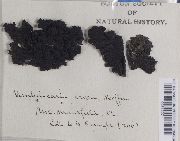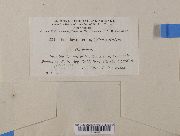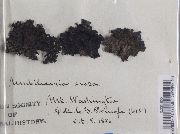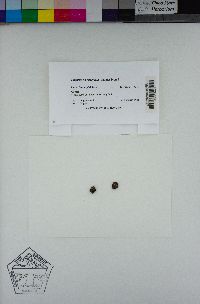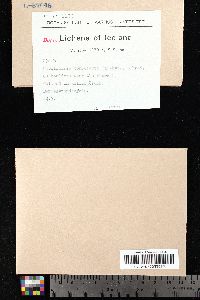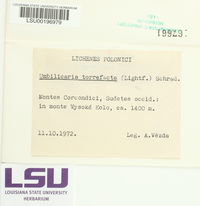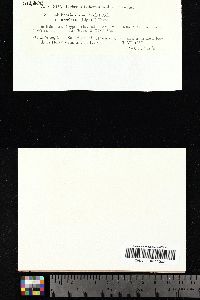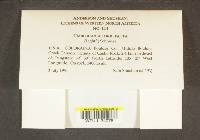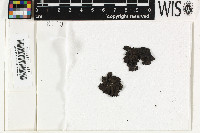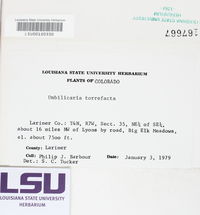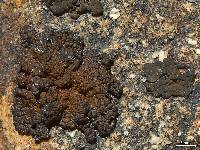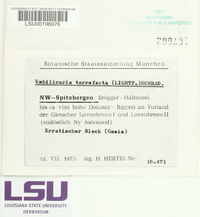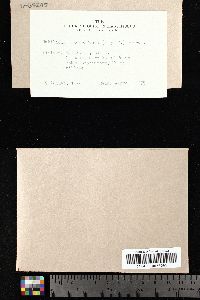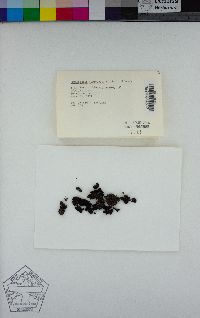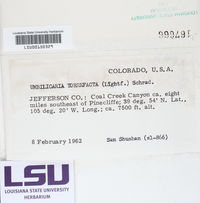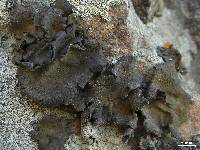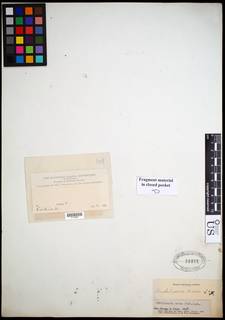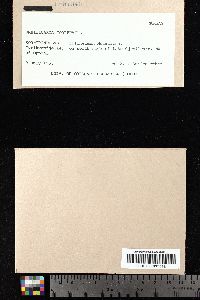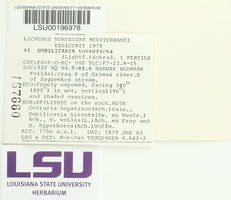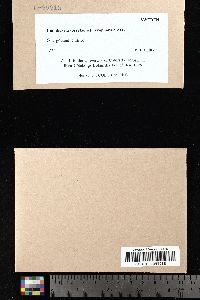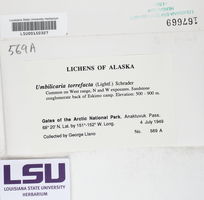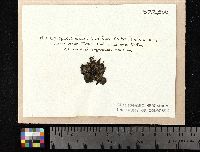
Consortium of Lichen Herbaria
- building a Global Consortium of Bryophytes and Lichens as keystones of cryptobiotic communities -
- Home
- Search
- Images
- Species Checklists
- US States: O-Z >
- US National Parks
- Central America
- South America
- US National Parks
- Southern Subpolar Region
|
|
|
|
Family: Umbilicariaceae
[Gyromium erosum (Weber) Wahlenb., moreGyrophora erosa (G. Weber) Ach., Gyrophora erosa f. erosa (Weber) Ach., Gyrophora erosa f. parvula Hav., Gyrophora erosa f. polyphylla Lynge, Gyrophora erosa var. erosa (Weber) Ach., Gyrophora erosa var. normalis Th. Fr., Gyrophora erosa var. torrefacta (Lightf.) Th. Fr., Gyrophora erosa var. torrida Ach., Gyrophora torrefacta (Lightf.) Cromb., Gyrophora torrefacta var. erosa (Weber) Lynge, Gyrophora torrefacta var. torrefacta (Lightf.) Cromb., Gyrophora torrida (Ach.) Röhl., Lecidea erosa (Weber) Spreng., Lichen erosus Weber, Lichen torrefactus Lightf., Umbilicaria erosa (Weber) Hoffm., Umbilicaria erosa f. erosa (Weber) Hoffm., Umbilicaria erosa f. nitens Frey, Umbilicaria erosa f. polyphylla (Lynge) H. Magn., Umbilicaria erosa f. subtorrida Vain., Umbilicaria erosa var. erosa (Weber) Hoffm., Umbilicaria erosa var. torrefacta (Lightf.) Frey, Umbilicaria erosa var. torrida (Ach.) Nyl., Umbilicaria torrefacta var. erosa (Ach.) Oxner, Umbilicaria torrida (Ach.) Nyl., Umbilicaria varia var. erosa (Weber) Leight., Usnea torrefacta (Lightf.) Schrad., Usnea torrefacta subsp. subtorrida (Vain.) N.S. Golubk. & Shapiro, Usnea torrefacta subsp. torrefacta (Lightf.) Schrad.] |
Nash, T.H., Ryan, B.D., Gries, C., Bungartz, F., (eds.) 2004. Lichen Flora of the Greater Sonoran Desert Region. Vol 2. Thallus: umbilicate, monophyllous, +circular to irregular in shape, with characteristic sieve-like perforations along the margins that are often shredded, 2-6 cm in diam. upper surface: medium to dark brown, often shiny, criss-crossed by dark fissures among slightly bumpy areolate-like structures medulla: white lower surface: beige to light brown, smooth to coarsely papillate, with trabeculae (plate-like structures) radiating from the umbilicus, rhizinomorphs scattered or dense Apothecia: common, black, partially immersed to sessile, gyrose, up to 2 mm in diam. asci: clavate, 8-spored ascospores: hyaline, simple, ellipsoid, 8-12 x 4-6 µm Spot tests: medulla K+ yellow, C+ red or C-, KC+ red or KC-, P+ orange Secondary metabolites: gyrophoric, lecanoric and stictic acids. Substrate and ecology: on siliceous rocks World distribution: Europe, Asia and North America. Sonoran distribution: upper conifer or alpine vegetation zones of southern California and Arizona. Notes: Umbilicaria torrefacta, a typically arctic/alpine species, is separated from the typically lower elevation U. angulata by its circular versus respectively angular apothecia. In addition, the occurrence of perforate margins is typical in U. torrefacta. |
Powered by Symbiota














